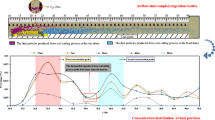Abstract
All dust control measures are necessary to reduce dust exposure in MDF (Medium Density Fibreboard)-milling, because of the high amount and fineness of the dust produced and a potential risk of exposure to formaldehyde or other glue chemicals during the machining of MDF. The most effective way of reducing dust exposure is to reduce the emission of dust at the source. Airborne dust emission was studied and modelled in the milling. In the milling of MDF, airborne dust emission was much higher than in the milling of solid materials. Milling of MDF produced airborne particles with a mass median diameter of 6–7 µm. The most significant factor affecting the amount of dust created from milling was average chip thickness. In order to reduce the amount of dust, milling parameters should be chosen so that the average chip thickness is greater than 0.05 mm. The average chip thickness could be obtained with different milling parameters, for example with different combinations of feed and traverse rates. The same chip thicknesses resulted in around the same percentage fraction of fine dust mass regardless of how the average chip thickness was obtained. The relationship between the percentage fraction of fine dust mass from the removed mass (c%) and the chip thickness (hm) was modelled and presented in the form of c% = 0.194 h m -1. The model developed can be used to estimate the percentage fraction of fine dust mass as a function of chip thickness. The model can be used in optimisation programs for CNC milling machines to minimize the airborne dust generated and to reduce dust exposure.
Zusammenfassung
Umfassende Messungen der Staubemission sind notwendig, um die Staubbelastung beim Fräsen von MDF zu reduzieren, insbesondere wegen der großen Menge und Feinheit des dabei erzeugten Staubes und der möglichen Belastung mit Formaldehyd oder anderen chemischen Bestandteilen aus den Klebstoffen. Am effektivsten kann die Staubbelastung bereits an der Quelle reduziert werden. Die Staubemission beim Fräsen wurde untersucht und modelliert. Beim Fräsen von MDF war die Staubemission um ein Vielfaches höher als beim Fräsen von Massivholz. Dabei haben die in die Luft emittierten Partikel einen mittleren Durchmesser von 6–7 µm (Median). Den größten Einfluss auf die Höhe der Staubbelastung hatte die durchschnittliche Spandicke. Um die Staubmenge zu reduzieren, sollte die Fräsmaschine so eingestellt werden, dass die durchschnittliche Spandicke größer als 0.05 mm ist. Die durchschnittliche Spandicke kann mit verschiedenen Maßnahmen erreicht werden, wie zum Beispiel mit unterschiedlichen Kombinationen des Längs- und Quervorschubs. Die gleichen Spandicken ergaben ungefähr den gleichen Anteil an Feinstaubmasse unabhängig davon, auf welche Weise die durchschnittliche Spandicke erzielt wurde. Der Anteil des Feinstaubs an der Gesamtmenge des abgetragenen Materials (c%) und der Spandicke (hm) wurde modelliert und durch die Gleichung c% = 0.194 h m -1 dargestellt. Das entwickelte Modell kann zur Schätzung des prozentualen Anteils an Feinstaubmasse in Abhängigkeit von der Spandicke verwendet werden. Auch kann es in Optimierungsprogrammen von CNC-Fräsmaschinen eingesetzt werden, um die erzeugte Staubmenge zu minimieren und die Staubbelastung zu verringern.
Similar content being viewed by others
References
Council Directive 1999/38/EC (1999) Amending for the second time Directive 90/394/EEC on the protection of workers from the risks related to exposure to carcinogens at work and extending it to mutagens. Official Journal L 138, pp 66–69
Gottlöber C (2002) Ein Weg zur Optimierung von Spanungsprozessen am Beispiel des Umfangsplanfräsens von Holz und Holzwerkstoffen. Erlangung des akademischen Grades. Technische Universität Dresden, Germany (in German)
Hemmilä P, Gottlöber C, Welling I (2003) Effect of cutting parameters to dust and noise in wood cutting, laboratory and industrial tests. In Abstracts: Proceedings of International Wood Machining Seminar 16. IWMS-16: 2003 Aug 24–27. Matsue, Japan
Hinds WC (1982) Aerosol technology. Properties, behaviour, and measurement of airborne particles. John Wiley & Sons Inc, USA
IARC (1995) Monographs on the evaluation of carcinogenic risks to humans. Volume 62. Wood dust and formaldehyde. International Agency for Research on Cancer, Lyon
Kauppinen T, Vincent R, Liukkonen T, Grzebyk M, Welling I (2004) The assessment of occupational exposure to wood dust in the European Union. In: Abstracts of the X2004. Arbo Wetenschap, Utrecht, Suppl 2:4–5
Luce D, Gerin M, Leclerc A, Morcet J F, Brugere J, Goldberg M (1993) Sinonasal cancer and occupational exposure to formaldehyde and other substances. Int J Cancer 53(2):24–31
Palmqvist J, Gustafsson S-I (1999) Emission of dust in planing and milling of wood. Holz Roh- Werkst 57:164–170
SCOEL (2002) Recommendation from the Scientific Committee on Occupational Exposure Limits for Wood Dust. SCOEL/SUM/102B
SFS 3866 (1990) Air quality. Stationary source emissions. Determination of particulate emissions, manual method, Finnish Standards Association
Vahtikari K, Ala-Laurinaho A, Paajanen T (2001) Work Environment in wood working industry (in Finnish). Bulletin 89. Helsinki University of Technology
Author information
Authors and Affiliations
Corresponding author
Rights and permissions
About this article
Cite this article
Rautio, S., Hynynen, P., Welling, I. et al. Modelling of airborne dust emissions in CNC MDF milling . Holz Roh Werkst 65, 335–341 (2007). https://doi.org/10.1007/s00107-007-0179-3
Published:
Issue Date:
DOI: https://doi.org/10.1007/s00107-007-0179-3




